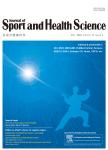Limb symmetry index in competitive alpine ski racers:Reference values and injury risk identification according to age-related performance levels
Limb symmetry index in competitive alpine ski racers:Reference values and injury risk identification according to age-related performance levels作者机构:Department of Sport ScienceUniversity of InnsbruckInnsbruck 6020Austria Department of Sport Science and KinesiologyUniversity of SalzburgSalzburg 5400Austria Research Unit for Orthopedic Sports Medicine and Injury PreventionInstitute of Psychology(ISA GJThe Health&Life Sciences University(UMIT)Innsbruck 6020Austria Gelenkpunkt-Sports and Joint SurgeryInnsbruck 6020Austria
出 版 物:《Journal of Sport and Health Science》 (运动与健康科学(英文))
年 卷 期:2018年第7卷第4期
页 面:405-415页
核心收录:
学科分类:0403[教育学-体育学] 04[教育学] 1002[医学-临床医学] 1010[医学-医学技术(可授医学、理学学位)]
主 题:年龄相关 风险因素 滑雪 损害 竞争 大规模集成电路 性能 索引
摘 要:Purpose: The aims of this study were to assess differences of limb symmetry index(LSI) in strength-and coordination-related tasks between high-level, competitive, noninjured ski racers of different age-related performance levels and to prospectively assess limb differences as a possible risk factor for traumatic and overuse injury in youth ski ***: The study(Study 1) included 285 high-level competitive ski racers(125 females, 160 males) of 3 age-related performance levels and based on the school system: 95 youth(10à14 years, secondary modern school), 107 adolescent(15à19 years, grammar school), and 83 elite athletes(20à34 years). To investigate the second aim(Study 2), 67 of the 95 youth athletes were included and any traumatic or overuse injuries were prospectively recorded over 2 seasons. All athletes performed 4 unilateral tests(strength related: one-leg counter movement jump(OL-CMJ) and one-leg isometric/isokinetic press strength test(OL-ILS); coordination related: one-leg stability test(OL-ST) and one-leg speedy jump test(OL-SJ)). The LSI was calculated by dividing the dominant leg by the nondominant leg and multiplying by 100. Kruskal-Wallis H tests and binary logistic regression analyses were ***: There were significant differences between the LSI of the 3 age-related performance-level groups only in the strength-related tests: the OL-CMJ(x2(2, 285) = 9.09; p = 0.01) and the OL-ILS(x2(2, 285) = 14.79; p 0.01). The LSI for OL-ILS was found to be a significant risk factor for traumatic injury in youth ski racers(Wald = 7.08; p 0.01). No significant risk factors were found for overuse ***: Younger athletes display slightly greater LSI values only in the strength-related tests. The cut-off value of limb differences of 10%for return to sport decisions seems to be appropriate for elite athletes, but for youth and adolescent athletes it has to be critically discussed. It seems to be necessary to define thresholds based o



